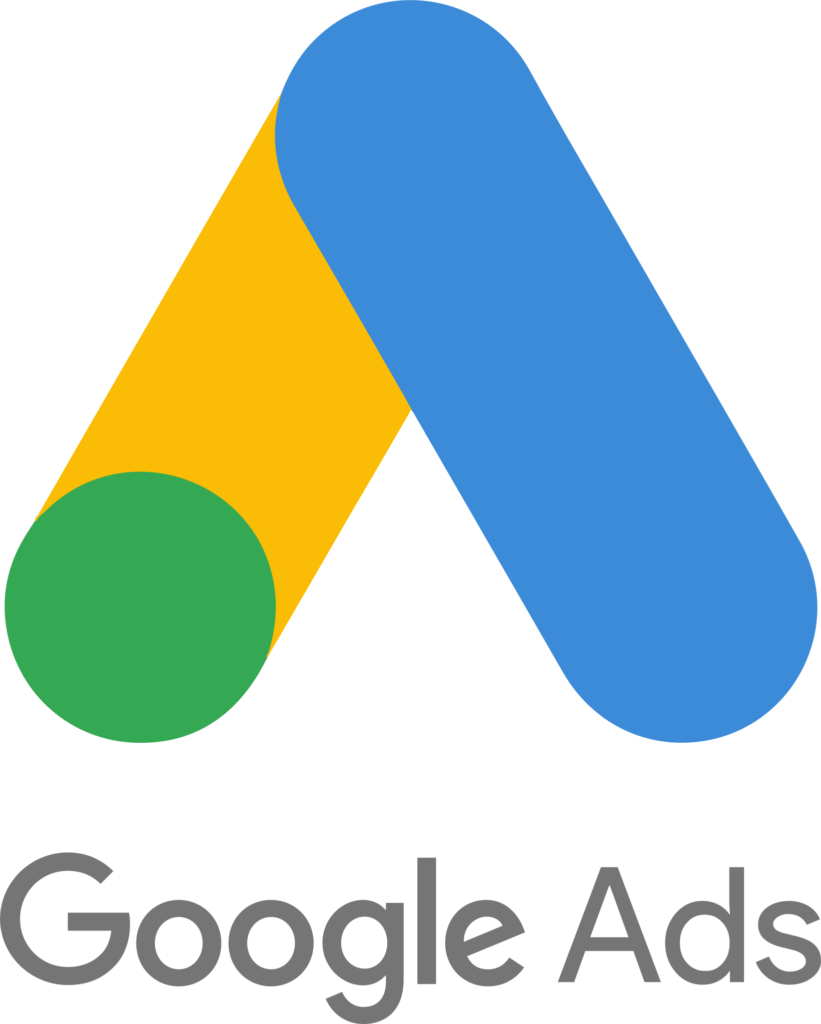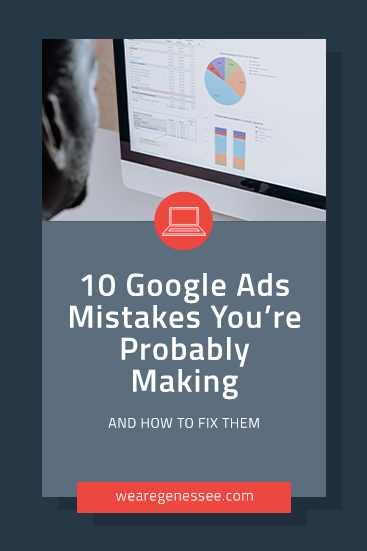Learn The 10 Google Ads Mistakes You’re Probably Making

Google Ads is an excellent tool for promoting your products and driving traffic to your website. In this post, we’ll discuss the 10 Google Ads mistakes that are most common among users at businesses and agencies alike (but not here at Genesse, of course!). By avoiding these mistakes and applying our suggestions, you will create a successful PPC ad campaign that accomplishes your company goals!
1. Too Many Key Words
This is one of the most common mistakes among Google Ads users. Adding too many keywords to your ad group will hurt your campaign and drain your daily marketing budget. Fortunately, there are several solutions you can apply to ensure that your Google Ads have just the right amount of keywords.
The Single Keyword Per Ad Group (SKAG) tactic allows you to create a singular ad optimized for each of your target keywords. This solution makes your ads more relevant to your target audience.
Tools like SEMrush and Google Keyword Planner can help you generate the right keywords for your ad copy. Adding strategic keywords to your ads will put your product in front of the right customers so that you can start making a profit.
Google recommends using 5-20 keywords per ad group. If you stay within that range and use your keywords to target a specific audience, you should be able to avoid the mistake of using too many keywords!
2. Counting Page Views As Conversion Actions
Conversion actions are specific customer actions that benefit your business. This includes online purchases, phone calls, and scheduling consultations. Each of these actions indicates that a customer is considering purchasing your services.
Treating every page view as a conversion action is like calculating how many people walk into the grocery store. Walking into the store doesn’t mean they will buy anything. For a consumer, viewing your landing page does not guarantee they will use your services. If your ads only attract viewing traffic, you will quickly lose track of your campaign budget and effectiveness.
To avoid this Google Ads mistake, set goals for how you want viewers to interact with your content, then focus on those conversion actions. For example, if you want to increase online purchases, make sure your customers can find your products when they click on your ads. Narrowing your focus on specific conversion actions will help you improve your campaigns so that they are optimized to accomplish your goals.
3. Relying On Auto Recommendations
Over the past few years, Google Ads has implemented a variety of recommendations to help users optimize their campaigns. Unfortunately, the recommendations are not tailored to fit company-specific goals. So, what should you do?
As the business owner or employee, you control which recommendations you accept. We advise you to review the suggestions monthly. During each review, you can evaluate which settings support your goals and which ones hinder your goals. There is nothing wrong with using any or all of the auto recommendations! Just make sure that each one supports your advertising goals.
4. Only Using Broad Match Keywords
Google Ads offers three match types for keywords: exact, phrase, and broad. While there is a time and a place for each match type, don’t get stuck using just one in your ad copy. Although broad-match keywords may be the easiest to use, they do not fit all ad campaigns.
Broad-match keywords are a great way to spread your ads across various platforms. The harm is that your ad may pair with queries you do not want to match. If “shoes” is your keyword, and your business sells designer women’s shoes, you don’t want your ad to pop up when someone searches for “dog shoes”. Only use broad-match keywords if you are confident they will perform well based on past usage.
5. Incorrectly Grouping Your Keywords
Ad groups should contain sub-groups with similar types of keywords. You should not compile all your keywords into one ad group. People will see the same ad for multiple products if you gather all your keywords into one ad group.
For example, if Apple put all their keywords into one ad group, consumers searching for the Macbook Pro would see the same ad for AirPods Pro, iPhone, and chargers. That would be highly frustrating for customers, and Apple would probably lose valuable business because of this mistake.
If you want people to click on your ad and buy your product, your ad copy must match the keyword consumers type into the search engine. Breaking your keywords into ad groups allows you to customize, monitor, and optimize your ads for the product you are selling.
6. Not Knowing Your CLV
Customer Lifetime Value (CLV) is also known as Lifetime Value (LTV) in the realm of Google Ads. This metric tracks how often a customer visits your site. It is important to calculate your CLV, so you know how many times an average customer uses your services.
You can use your CLV to determine whether you are making a profit with Google Ads. You are doing well if your ads pay for themselves by attracting traffic that buys your products. If you are losing money because you are paying for ads that don’t bring traffic and therefore don’t sell your products, you need to reevaluate your strategy. You may lose money initially, but you can make it back over the lifetime of doing business with a customer. Your CLV will help you determine if your ads bring in customers and profits that make the ads worth your time and money.
The general formula for calculating your CLV is:
Customer Lifetime Value = Customer Value * Average Customer Lifespan
A great tool for measuring your CLV is the KISSmetrics Customer Lifetime Value article. Once you calculate your CLV, you will know how to adjust your campaign goals accordingly.
7. Not Using Negative Keywords
You need negative keywords in your ad groups and campaigns so that your ads show up under your products. If you do not use negative keywords, your ads will match with the wrong products.
For example, if you own an online store that sells designer women’s clothes, not athletic clothes, you do not want your ads to show when a customer searches for “women’s athletic clothing.” If you want your ads to show for “women’s clothing” searches, you need to add “athletic” as a negative keyword.
Google Analytics and Ads will help you determine which search terms to add as negative keywords. These tools will also determine whether the negative keyword needs to be added at the campaign or group level.
8. Falling In Love With Your Copy
You should like the ad copy you write, but you shouldn’t get attached to it. Getting attached to your ad copy will cloud your judgment as you try to optimize your ads for your campaign. You should constantly test your copy for optimization and improvement.
As you test your copy, try different variations. You can pair two headline variations, change your body copy, or add a call to action. Once you get measurable results, choose the ad copy that brings the most benefits based on your goals. Don’t elevate your love of your copy over the results that you see. If the analytics say that something needs to change, change it!
9. Not Knowing Your Competition
This is one of the biggest mistakes you can make in Google Ads. You need to know your competition if you want to promote your products successfully. If you have researched your industry, you already know some of your competitors. You can easily observe your competitors by going into “incognito” mode on your browser and typing in the company name.
Another type of competitor you need to consider is your competitors at auction. Google will use its algorithm to identify industry competitors you may not know about. You can check the Auction Insights in Google Ads to learn about these competitors so that you are not caught off guard.
Once you know who you are competing against, study their ads, figure out what keywords they are using, and look at their landing pages. Put yourself in your customer’s shoes as you research. Which ads are you most drawn to? Which landing pages are the most appealing to your eye? These questions will help you gauge how your ads compare to your competition.
As you research, take notes on your competitors’ ads and landing pages. Use your notes to make user-friendly and eye-catching improvements. Once you are satisfied with your edits, test your new ad copy. Whatever you do, don’t stop researching your competition!
10. Under-Budgeting Your Campaign
Many people put their Google Ads on a tight budget and expect their business to thrive. This is simply not realistic. A tight budget does not allow room for testing and re-writing your ads. Spoiler alert: your ads probably won’t perform well without some trial and error.
A small budget will frustrate you because you will think the ads aren’t working for you. However, the software isn’t the problem; your budget is. You need to start with a budget that gives buffer room for you to tweak your campaigns and ad copy. Give yourself time to become familiar with Google Ads. Once familiar, you can strategically optimize your campaign to achieve your goals.
Following these recommendations will help you avoid the 10 Google Ads mistakes people commonly make. If you apply these suggestions, you will be well on your way to creating ad campaigns that help you reach your company goals!
